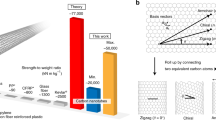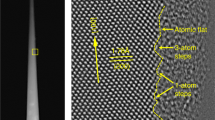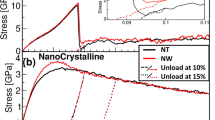Abstract
Friction and wear are two main causes of mechanical energy dissipation and component failure, especially in micro/nanomechanical systems with large surface-to-volume ratios. In the past decade there has been an increasing level of research interest regarding superlubricity1,2,3,4,5, a phenomenon, also called structural superlubricity, in which friction almost vanishes between two incommensurate solid surfaces2,3. However, all experimental structural superlubricity has been obtained on the microscale or nanoscale, and predominantly under high vacuum. Here, we show that superlubricity can be realized in centimetres-long double-walled carbon nanotubes (DWCNTs) under ambient conditions. Centimetres-long inner shells can be pulled out continuously from such nanotubes, with an intershell friction lower than 1 nN that is independent of nanotube length. The shear strength of the DWCNTs is only several pascals, four orders of magnitude lower than the lowest reported value in CNTs and graphite. The perfect structure of the ultralong DWCNTs used in our experiments is essential for macroscale superlubricity.
This is a preview of subscription content, access via your institution
Access options
Subscribe to this journal
Receive 12 print issues and online access
$259.00 per year
only $21.58 per issue
Buy this article
- Purchase on Springer Link
- Instant access to full article PDF
Prices may be subject to local taxes which are calculated during checkout




Similar content being viewed by others
References
Dienwiebel, M. et al. Superlubricity of graphite. Phys. Rev. Lett. 92, 126101 (2004).
Hirano, M. & Shinjo, K. Atomistic locking and friction. Phys. Rev. B 41, 11837 (1990).
Hirano, M., Shinjo, K., Kaneko, R. & Murata, Y. Anisotropy of frictional forces in muscovite mica. Phys. Rev. Lett. 67, 2642–2645 (1991).
Hirano, M., Shinjo, K., Kaneko, R. & Murata, Y. Observation of superlubricity by scanning tunneling microscopy. Phys. Rev. Lett. 78, 1448–1451 (1997).
Martin, J., Donnet, C., Le Mogne, T. & Epicier, T. Superlubricity of molybdenum disulphide. Phys. Rev. B 48, 10583 (1993).
Szeri, A. Z. Tribology: Friction, Lubrication, and Wear (Hemisphere, 1980).
Amiri, M. & Khonsari, M. M. On the thermodynamics of friction and wear―a review. Entropy 12, 1021–1049 (2010).
Yunhui, M., Dehua, T., Xicheng, W. & Qinghua, L. Research on friction-coatings with activated ultra-thick tin-base. Adv. Tribol. 915–919 (2010).
Erdemir, A. & Martin, J. M. Superlubricity (Elsevier, 2007).
Andersson, J., Erck, R. & Erdemir, A. Friction of diamond-like carbon films in different atmospheres. Wear 254, 1070–1075 (2003).
Erdemir, A. & Donnet, C. Tribology of diamond-like carbon films: recent progress and future prospects. J. Phys. D 39, R311 (2006).
Sokoloff, J. Theory of the effects of multiscale surface roughness and stiffness on static friction. Phys. Rev. E 73, 016104 (2006).
Erdemir, A., Eryilmaz, O. & Fenske, G. Synthesis of diamondlike carbon films with superlow friction and wear properties. J. Vac. Sci. Technol. A 18, 1987–1992 (2000).
Liu, Z. et al. Observation of microscale superlubricity in graphite. Phys. Rev. Lett. 108, 205503 (2012).
Cumings, J. & Zettl, A. Low-friction nanoscale linear bearing realized from multiwall carbon nanotubes. Science 289, 602–604 (2000).
Li, Y. et al. Molecular mechanics simulation of the sliding behavior between nested walls in a multi-walled carbon nanotube. Carbon 48, 2934–2940 (2010).
Xia, Z. & Curtin, W. Pullout forces and friction in multiwall carbon nanotubes. Phys. Rev. B 69, 233408 (2004).
Zheng, Q. & Jiang, Q. Multiwalled carbon nanotubes as gigahertz oscillators. Phys. Rev. Lett. 88, 45503 (2002).
Kis, A., Jensen, K., Aloni, S., Mickelson, W. & Zettl, A. Interlayer forces and ultralow sliding friction in multiwalled carbon nanotubes. Phys. Rev. Lett. 97, 25501 (2006).
Fennimore, A. et al. Rotational actuators based on carbon nanotubes. Nature 424, 408–410 (2003).
Yu, M. F., Yakobson, B. I. & Ruoff, R. S. Controlled sliding and pullout of nested shells in individual multiwalled carbon nanotubes. J. Phys. Chem. B 104, 8764–8767 (2000).
Yu, M. F. et al. Strength and breaking mechanism of multiwalled carbon nanotubes under tensile load. Science 287, 637–640 (2000).
Hong, B. H. et al. Extracting subnanometer single shells from ultralong multiwalled carbon nanotubes. Proc. Natl Acad. Sci. USA 102, 14155–14158 (2005).
Guo, W., Zhong, W., Dai, Y. & Li, S. Coupled defect-size effects on interlayer friction in multiwalled carbon nanotubes. Phys. Rev. B 72, 075409 (2005).
Huhtala, M. et al. Improved mechanical load transfer between shells of multiwalled carbon nanotubes. Phys. Rev. B 70, 045404 (2004).
Peng, B. et al. Measurements of near-ultimate strength for multiwalled carbon nanotubes and irradiation-induced crosslinking improvements. Nature Nanotech. 3, 626–631 (2008).
Wen, Q. et al. 100 mm long, semiconducting triple-walled carbon nanotubes. Adv. Mater. 22, 1867–1871 (2010).
Wen, Q. et al. Growing 20 cm long DWNTs/TWNTs at a rapid growth rate of 80–90 µm/s. Chem. Mater. 22, 1294–1296 (2010).
Zhang, R. et al. Superstrong ultralong carbon nanotubes for mechanical energy storage. Adv. Mater. 23, 3387–3391 (2011).
Zhang, R. et al. Optical visualization of individual ultralong carbon nanotubes by chemical vapour deposition of titanium dioxide nanoparticles. Nature Commun. 4, 1727 (2013).
Zheng, Q., Liu, J. Z. & Jiang, Q. Excess van der Waals interaction energy of a multiwalled carbon nanotube with an extruded core and the induced core oscillation. Phys. Rev. B 65, 245409 (2002).
Kis, A. & Zettl, A. Nanomechanics of carbon nanotubes. Phil. Trans. R. Soc. Lond. A 366, 1591–1611 (2008).
Benedict, L. X. et al. Microscopic determination of the interlayer binding energy in graphite. Chem. Phys. Lett. 286, 490–496 (1998).
Gnecco, E., Bennewitz, R., Gyalog, T. & Meyer, E. Friction experiments on the nanometre scale. J. Phys. 13, R619–R641 (2001).
Ding, F., Harutyunyan, A. R. & Yakobson, B. I. Dislocation theory of chirality-controlled nanotube growth. Proc. Natl Acad. Sci. USA 106, 2506–2509 (2009).
Xu, Z., Li, X., Yakobson, B. I. & Ding, F. Interaction between graphene layers and the mechanisms of graphite's superlubricity and self-retraction. Nanoscale 5, 6736–6741 (2013).
Wei, X. L., Liu, Y., Chen, Q., Wang, M. S. & Peng, L. M. The very-low shear modulus of multi-walled carbon nanotubes determined simultaneously with the axial Young's modulus via in situ experiments. Adv. Funct. Mater. 18, 1555–1562 (2008).
Acknowledgements
This work was supported by the Foundation for the National Basic Research Program of China (Program Number 2011CB932602 and 2013CB934200) and the National Natural Science Foundation of China (Grant Number 51372132 and 60925003). The authors thank Dezheng Wang and Wengen Ou-Yang for helpful discussions.
Author information
Authors and Affiliations
Contributions
F.W. proposed and supervised the project. R.F.Z. designed and performed the experiments and wrote the manuscript. Y.Y.Z. co-supervised the project and designed the outline of the manuscript. Z.Y.N. participated in most experiments. Q.S.Z., Q.S., Q.Z. and Q.W.Z. participated in data analysis and manuscript preparation. H.H.X. participated in the synthesis of ultralong CNTs.
Corresponding authors
Ethics declarations
Competing interests
The authors declare no competing financial interests.
Supplementary information
Supplementary information
Supplementary Information (PDF 2198 kb)
Rights and permissions
About this article
Cite this article
Zhang, R., Ning, Z., Zhang, Y. et al. Superlubricity in centimetres-long double-walled carbon nanotubes under ambient conditions. Nature Nanotech 8, 912–916 (2013). https://doi.org/10.1038/nnano.2013.217
Received:
Accepted:
Published:
Issue Date:
DOI: https://doi.org/10.1038/nnano.2013.217
This article is cited by
-
Influence of structural depth of laser-patterned steel surfaces on the solid lubricity of carbon nanoparticle coatings
Friction (2023)
-
Low friction of superslippery and superlubricity: A review
Friction (2023)
-
Pseudo-break imaging of carbon nanotubes for determining elastic bending energies
Nano Research (2023)
-
Achieving macroscale superlubricity with ultra-short running-in period by using polyethylene glycol-tannic acid complex green lubricant
Friction (2023)
-
Macro-superlubricity in sputtered MoS2-based films by decreasing edge pinning effect
Friction (2023)



